Distortion? False information? Conspiracy theories? Hacked email? Climate scientists have known all this for decades. What can be learned from their rich experience with climate propaganda.
The world is slowly waking up. “Post-truth” was declared the word of the year 2016 by the Oxford Dictionaries. Finally, people start to widely appreciate how dangerous the epidemic of fake news is for democracy.
Stir up hate, destroy discourse, make insane claims until no one can distinguish the most bizarre absurdity from the truth any more.
Thus the Austrian author Robert Misik aptly describes the strategy of right-wing populists.
Some call it “alternative facts”. (Those are the convenient alternative to true facts.) Let’s simply call it propaganda.
Fake News
Confusing people with fake news is not an invention of the Brexit and Trump campaigns. Here are some examples of simply false to outright crazy claims that “climate skeptics” have used to fool lay people for at least two decades (the links lead to explanations):
The greenhouse effect cannot exist, because it supposedly violates the 2nd law of thermodynamics. Since the late 1990s there has been no warming. In the Middle Ages Greenland was almost free of ice. The climate has cooled dramatically, Daily Mail and Breitbart News recently claimed (see the following video, in which meteorologist Kait Parker from the Weather Channel charmingly debunks this).
The “hockey stick” is broken. Sea levels are falling (claimed Björn Lomborg ). Etc. etc.
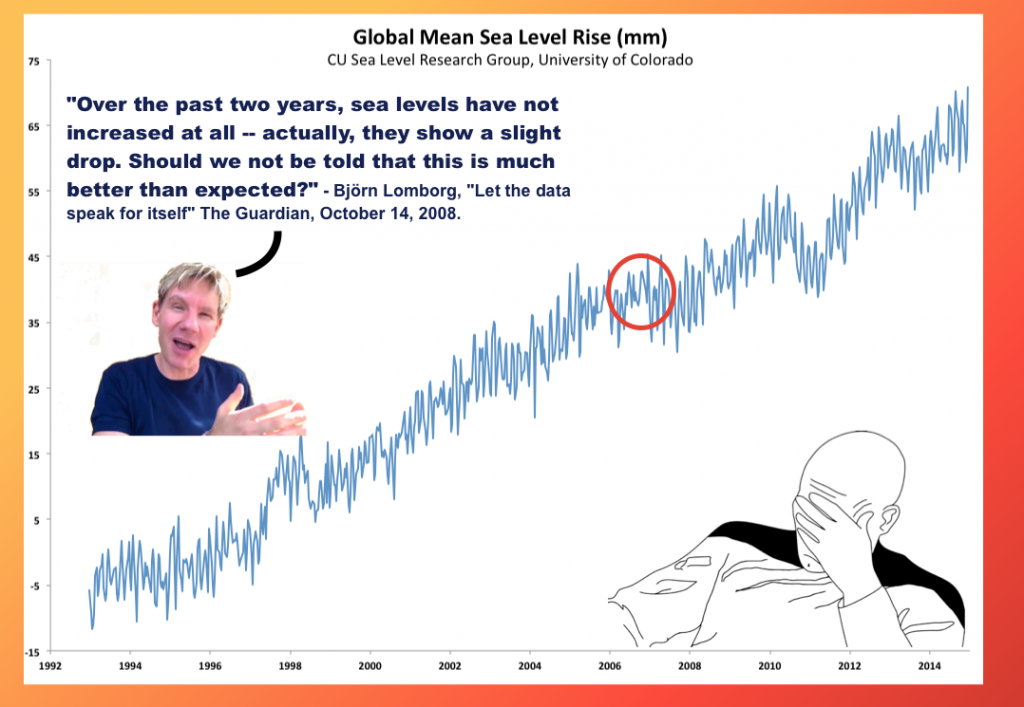
Graph: Greg Laden , with permission
The latest salvo in this is the claim by David Rose (yet again) in the British tabloid Daily Mail that “world leaders were duped into investing billions over manipulated global warming data”. Check out the “data manipulation” yourself in the next graph to see immediately how credible this story is. Rose used a misleading graph and cited a retired “whistleblower”, John Bates, who has since told AP that there was “no data tampering, no data changing, nothing malicious.”
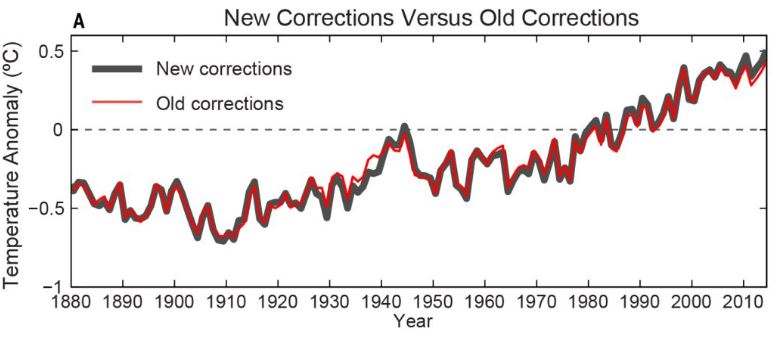
The key graph from Karl et al. (2015), showing the old NOAA data in red and the improved new version in black. Could the difference of a few hundredths of a degree have duped world leaders into signing on to the Paris Climate Agreement? (Mind you, the new version has been independently verified against the latest high-quality observational data and merely brings the NOAA data in line with the other global surface temperature data sets.)
And in any case, climate change is an eco-marxist scam (writes the Oslo terrorist Anders Breivik in his manifesto – with reference to hacked climate researchers’ emails.)
Hacked mail
Among the dirty tactics in the US election campaign was the spread of hacked emails in the weeks before the election. US intelligence agencies have come to the conclusion that Russia has tried specifically to influence the US elections in order to help Trump.
To climate scientists that sounds familiar. Before the climate summit in Copenhagen in 2009 (where failed what in 2015 in Paris finally succeeded after 50 years of dithering: a global climate treaty), numerous emails from climate researchers from the preceding 14 years appeared on a server in the Russian city of Tomsk. They had been stolen from the British Climate Research Unit (CRU). British media speculated about evidence for a role of the Russian secret service FSB (who has an office at Tomsk) at the time; the British police have failed to identify the perpetrators of the data theft. On climate denier blogs and in many media these mails were hyped up to a “climategate” scandal and out-of-context tidbits were paraded to discredit climate research. For example, the Daily Telegraph headlined: “This is the worst scientific scandal of our generation”.
The problem with this hype: in those climate scientist emails, there wasn’t even the slightest indication of any misconduct or reasons for doubt about global warming, as a full eight thorough investigations later proved. The best thing the climate deniers could find were the phrases “Mike’s trick” and “hide the decline,” which was presented as if scientists were trying to hide that global temperatures are really falling. Which is false of course (they are rising), and which wasn’t what the quote referred to, as the context in the mail concerned immediately shows.
Nevertheless, from the point of view of climate deniers, the email hack was a terrific success in influencing public opinion. This can even be seen in a recent interview of the New York Times with Donald Trump. The one where Trump’s statement that he was “open” was widely interpreted as if he might reconsider his position on climate change. In fact, he said :
It’s a very complex subject. I’m not sure anybody is ever going to really know. I know we have, they say they have science on one side but then they also have those horrible emails that were sent between the scientists. Where was that, in Geneva or wherever five years ago? Terrible. Where they got caught, you know, so you see that and you say, what’s this all about. I absolutely have an open mind.
It is shocking that a US president apparently bought into the propaganda about “climategate”. I guess Trump really doesn’t know any better – he’s known for often claiming demonstrably false things he got “off the Internet”. But leading people from his team (like Myron Ebell or the new EPA chief Scott Pruitt) are among those who have systematically been spreading such fake news about climate. Even the sober New York Times headlined on the nomination of Pruitt: „Trump Picks Scott Pruitt, Climate Change Denialist, to Lead E.P.A.“ According to the Guardian, at least 9 senior members of Trump’s team deny basic scientific knowledge about climate change.
Threat and intimidation
Many climate scientists are subject to threats and hate mail. My colleague and Realclimate cofounder Michael Mann got threats against him and, worse still, his family. This went as far as a letter with white powder, which was sent to Mike at the height of the anthrax scare and led to the evacuation of the university building by the police. In Australia, where I held a visiting professorship last winter, after anonymous threats my colleagues are working in a locked security area of the university, which can only be entered with a chip card. Two weeks ago, I was called “vermin” (“Schädling” in German – a word last used about human beings by the Nazis) and threatened with death for me and my family if I were to publish another blog article. This is how afraid some people are of words, of an open, reasoned discussion.
These intimidations have a chilling effect. I know some (especially younger) colleagues who prefer not to publicly comment on climate science, to avoid becoming a target.
Doubt as a product
There has long been a consensus in the scientic community that human activities are primarily responsible for global warming. The physics is understood, the evidence is clear and overwhelming. Scientific academies and professional organizations from all over the world have clearly stated this. The doubts about climate science, which are still widespread among lay people, are a product with an industry behind it. Hundreds of millions of dollars are pumped annually by (mostly fossil) interest groups into “think tanks” which promote doubts by parading self-styled “experts” and pseudo-studies. Some are the same PR folks who previously tried to portray the harm from smoking as scientifically unproven.
The British author George Monbiot recently wrote in a highly recommended article :
I first encountered the machine when writing about climate change. The fury and loathing directed at climate scientists and campaigners seemed incomprehensible until I realised they were fake: the hatred had been paid for. The bloggers and institutes whipping up this anger were funded by oil and coal companies.
The oil company Exxon knew, 40 years ago, how harmful their products are to the climate. In the US, public attorneys are currently investigating because Exxon systematically deceived the public about these findings.
But Trump, who owns holdings in oil companies, has now appointed former Exxon CEO Rex Tillerson as Secretary of State. Tillerson has received a friendship award from Putin, and in 2012 he has sealed a $ 500 billion oil drilling deal in the Russian Arctic, which is currently blocked because of sanctions over the annexation of Crimea – one of the plausible motives for Putin to support Trump in the election campaign. (A number for comparison to those 500 billion: Russia’s total military spending was $ 66 billion in 2015.) Trumps administration is expected to aggressively push fossil fuel business – at the cost of the stability of the climate and people suffering from the increasing droughts and extreme events all over the world.
The flood of paid or politically motivated propaganda is not just a threat to democracy. It is a danger to humanity’s livelihood: a stable climate, reliable crops, a life-giving biosphere. It is a relapse behind the time of scientific enlightenment. What can you do about it, and what should you rather leave?
What is not helpful
Ignoring the danger. The problem won’t go away by ignoring it. Propaganda and conspiracy theories are increasing dramatically, as the Guardian shows with a number of examples and statistics. In the social networks, the most popular climate change item of the past six months was not a carefully researched article by a science journalist but the #fakenews “Tens of Thousands of Scientists Declare Climate Change a Hoax”.
Normalizing nonsense. It is not helpful when some media keep citing nonsense spread by dubious anti-climate-science lobby groups as if this were a part of a normal “scientific debate”. Lobby groups that systematically spread disinformation, defamation, or hatred should be named as such and not be cited as if they were just normal discussion contributors.
Going into hiding. One should not duck away out of fear or opportunism, when the open society (and that includes science) is being attacked.
False balance. When the propaganda film “The Great Global Warming Swindle” was broadcast in the UK Channel 4 with its misleading graphics, false statements, fabricated data , etc., the station justified this thus: “This is a controversial film but we feel that it is important that all sides of the debate are aired.” This is only true if there is actually a serious “other side of the debate” that puts forth honest arguments. Or is there in reporting about AIDS always someone for the sake of balance, who claims AIDS is not caused by the HIV virus? The well-known problem of “false balance” in the media has resulted in only a small minority of the public understanding that there is an overwhelming consensus in the scientific community. A majority of people falsely believes that climate researchers are split into two roughly equal camps about the causes of global warming.
What we should do
Check sources! To avoid becoming a gullible victim of fake news, one needs to critically check the sources of news. Is a piece of news originating from the Washington Post, or from some fringe website? A serious newspaper with professional journalistic standards and a reputation to defend is a priori much more credible – but not a guarantee either. Even some mainstream media repeat falsehoods from climate deniers and (probably) consider this critical science journalism. I don’t need to mention specific examples here; our readers know plenty anyway. Checking sources also means: are cited experts really as prestigious as claimed? Today, thanks to scientific publication databases, you can easily verify that. Is a media report about some scientific finding based on a study in a peer reviewed journal? What do those media say whose core competence is science (e.g. Scientific American)?
Gather the views of independent experts. A very useful initiative in this regard is Climate Feedback, which solicits and publishes comments from a whole range of scientists about media articles on climate.
Enlighten. The best antidote against false news is true information with well-documented facts. One advantage of the Internet: everything I write in an article I can support with links, so everyone can verify the evidence. In case of statements on science, the ultimate evidence is usually studies in the peer-reviewed literature. Anyone who makes strong claims to laypeople, but does not publish them for discussion by professionals in relevant specialist journals, may well be more interested in propaganda than in science. False claims should be rebutted by those who understand the subject (but without giving the false claims more prominence).
Illuminate the background. Instead of citing lobby groups like a normal voice in a scientific discussion, one should illuminate their background and funding sources. Useful resources for checking the background of climate skeptics are e.g. the Realclimate Wiki and DeSmogBlog (here their background on David Rose).
Unfortunately there is no magic formula or panacea against the lobby activities of powerful interest groups who are deceiving the public by means of propaganda. Ultimately, only the citizens of the open society can defend themselves by making the effort to think and check rather than just being gullible. And by being willing to pay for quality journalism. If you’re not paying for the news you are reading, someone else is. And they might not have your best interest in mind.
As Immanuel Kant said:
Enlightenment is man’s emergence from his self-imposed immaturity.
Self-imposed.
Weblinks
The Atlantic: How to Deal With the Lies of Donald Trump: Guidelines for the Media (core statement: clearly denounce lies as such – and not just call them “controversial” etc.)
Guardian: BBC climate coverage is evolving, but too slowly (On the “false balance” problem of the BBC.)
The Climate Feedback project regularly makes a critical commentary on media articles by scientists
Washington Post: I’m a scientist who has gotten death threats
Scientific American: The War on Facts is a War on Democracy







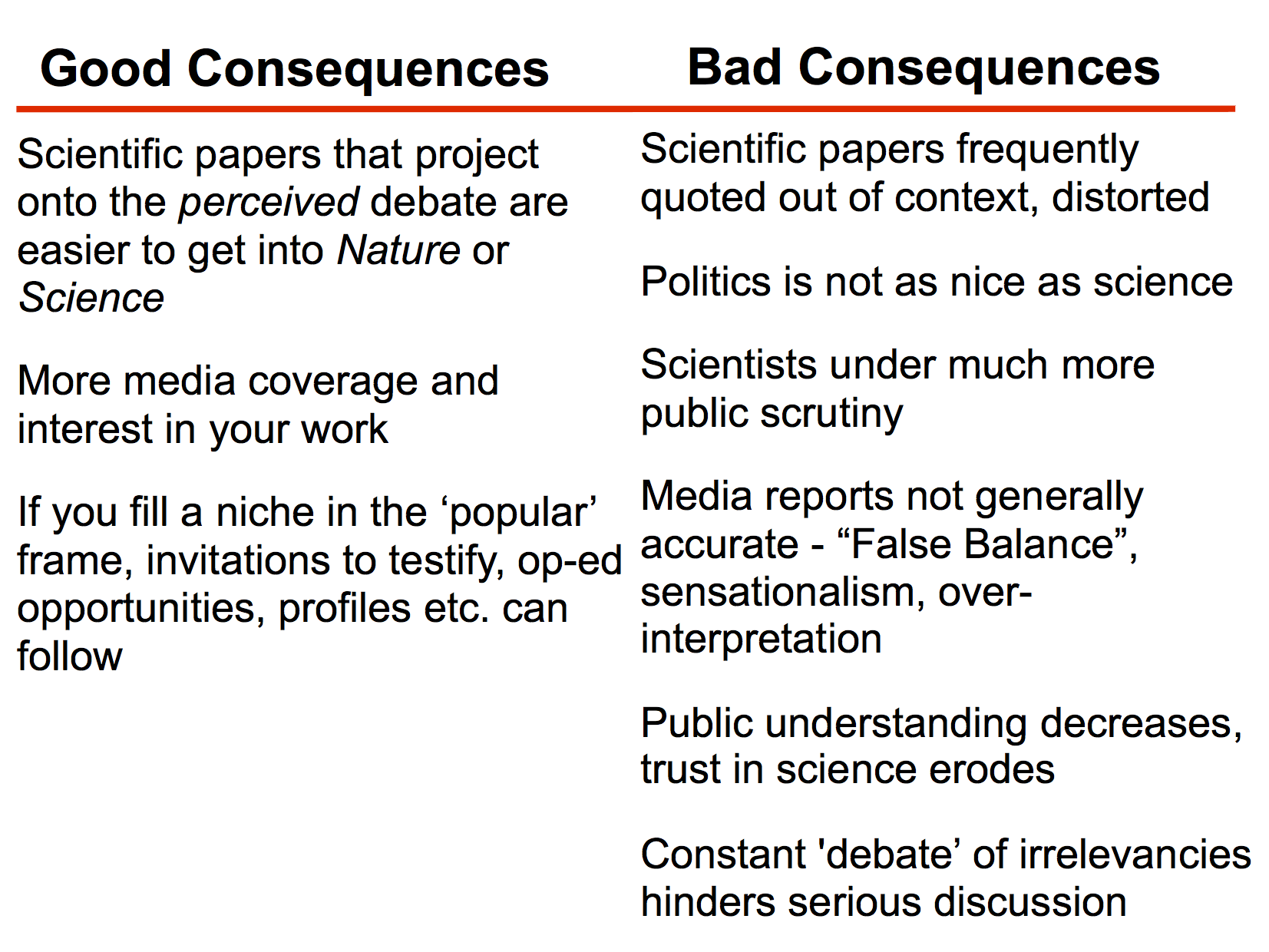





 Valentine’s Day can be both a blessing and a curse. On the one hand, it’s a wonderful opportunity for us to remind our loved ones how much we care about them. On the other, we sometimes feel as though we’re drowning in endless piles of pink greeting cards, teddy bears and boxes of mediocre drug store candy.
Valentine’s Day can be both a blessing and a curse. On the one hand, it’s a wonderful opportunity for us to remind our loved ones how much we care about them. On the other, we sometimes feel as though we’re drowning in endless piles of pink greeting cards, teddy bears and boxes of mediocre drug store candy.
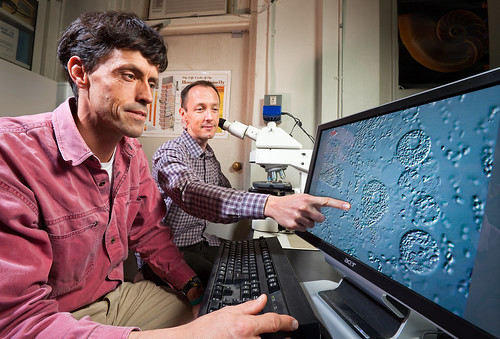

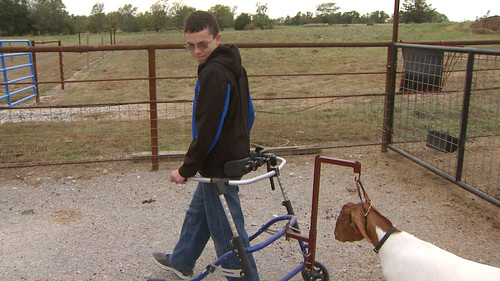

 Most summers since I was a child, my father would insist on taking an extended hike to escape from the struggle of being a small businessman and soak in the vistas of the Puget Sound in Washington State. My earliest memories of childhood involved weaving up switchbacks that carved through the dense canopy of Douglas-fir, Western hemlock and cedar that led to Lena Lake Campground in the Olympic National Forest. On these yearly getaways, my father imbued me with some of life’s most important lessons and taught me what it meant to respect the wonders that the Earth has to offer us.
Most summers since I was a child, my father would insist on taking an extended hike to escape from the struggle of being a small businessman and soak in the vistas of the Puget Sound in Washington State. My earliest memories of childhood involved weaving up switchbacks that carved through the dense canopy of Douglas-fir, Western hemlock and cedar that led to Lena Lake Campground in the Olympic National Forest. On these yearly getaways, my father imbued me with some of life’s most important lessons and taught me what it meant to respect the wonders that the Earth has to offer us.